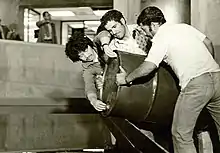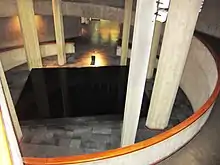Noriyuki Haraguchi
Noriyuki Haraguchi (1946-2020) was a Japanese artist who was known for his use of industrial materials.[1]
Noriyuki Haraguchi | |
|---|---|
 Noriyuki Haraguchi installing Oil Pool at the Museum of Contemporary Art of Tehran, 1977 | |
| Born | 1946 Yokosuka, Japan |
| Died | 2020 |
| Nationality | Japanese |
| Education | Nihon University, Tokyo |
| Known for | sculpture, installation art |
Notable work | Oil Pool (1971) |

Early life
Haraguchi was born in Yokosuka, Japan in 1946. He studied at the Nihon University in Tokyo.[1]
Work
Mono-ha
Haraguchi was associated with Mono-ha (School of Things), a 1960s art movement in Japan and Korea that explored the correlations between the natural and industrial worlds.[1][2] While his contemporaries, Nobuo Sekine, Lee Ufan and Kishio Suga are known for using natural materials, Haraguchi used industrial components such as waste oil, I-beams, automobile parts, plastics, and rubber.[3][4]
Anti-war works
Haraguchi often recreated detritus from airplanes, ships and weapons of mass destruction in his sculptures, such as A-7 E Corsair II (2011), Tsumu 147 (1966),[4] and Battleship Ref. A (1966).[5] His iconic sculpture A-4E Skyhawk (1968–69) was a reproduction at full-scale of the U.S. Navy fighter jet of the same name. The sculpture was created behind barricades at Nihon University during a student demonstration when riot police took over the campus during the protests against the Vietnam War.[3][6]
Matter and Mind (Oil Pool)
His best known work is Oil Pool (1971), that was first shown in Kassel, Germany at Documenta 6.[1][2] These sculptures consist of a low-slung rectangular containment structure constructed of steel and filled with thick, opaque waste oil with a glossy surface that appears to be polished black stone. During his lifetime, he created about 20 of these sculptures throughout the world. The sculpture, in its manifestation in Tehran, measures 14 by 21 feet, and 7 inches deep. It contains approximately 1,190 gallons of oil.[7] The official title of the sculpture is Matter and Mind.[7]
Critical reception
Haraguchi's work has been described as simultaneously personal and political; as his birthplace, Yokosuka, is a port city where the United States deployed its forces during the Vietnam war era. His work references the military-industrial complex and the correlation between Japanese modernity and the United States military relationship to it.[6]
Exhibitions
Haraguchi's work has been exhibited in the Museum of Modern Art,[8] New York, the Tate Museum,[9] the Hamburger Kunsthalle, the Städtische Galerie, Munich, and other venues.[2]
Collections
Oil Pool was acquired by the Tehran Museum of Contemporary Art for their permanent collection.[1][10] Haraguchi's work is also in the collection of the Tate Modern Museum, London[11] and the Kröller-Müller Museum in the Netherlands.[12]
Catalogue raisonné
A catalogue raisonné was produced on his work, Noriyuki Haraguchi: Catalogue Raisonne 1963-2001, in German and English; Helmut Friedel editor, published by Hatje Cantz Publishers in 2001.[13]
References
- Greenberger, Alex. "Noriyuki Haraguchi, Key Figure in Japanese Art Scene Behind "Oil Pool" work has died at 74". Art News. Retrieved 20 September 2020.
- "Obituary: Noriyuki Haraguchi (1946–2002)". Art Asia Pacific. Retrieved 20 September 2020.
- "Noriyuki Haraguchi Biography". Fergus McCaffrey Gallery. Retrieved 20 September 2020.
- Koplos, Janet (6 May 2012). "Noriyuki Haraguchi". Art in America. Retrieved 20 September 2020.
- Corwin, William (1 June 2012). "Noriyuki Haraguchi". Frieze. Retrieved 20 September 2020.
- Farago, Jason (2012). "Critic's Pick New York: Noriyuki Haraguchi". Artforum. Retrieved 20 September 2020.
- "Returning to Iran, Japanese artist finds his oil sculpture 'frozen in time". Times of Israel. 22 October 2017. Retrieved 20 September 2020.
- "Noriyuki Haraguchi". Museum of Modern Art, New York. Retrieved 20 September 2020.
- "Noriyuki Haraguchi, born 1946". Tate Museum, UK. Retrieved 20 September 2020.
- "Japanese artist Noriyuki Haraguchi, creator of Tehran museum's "Oil Pool", dies at 74". Tehran Times. 4 September 2020. Retrieved 20 September 2020.
- "IN TATE MODERN Materials and Objects: A View From Tokyo: Between Man and Matter". Tate Modern Museum. Retrieved 20 September 2020.
- "Untitled NORIYUKI HARAGUCHI (1946)". Kröller-Müller Museum. Retrieved 20 September 2020.
- "Noriyuki Haraguchi Catalogue raisonné 1963-2001". Hatje Cantz Publishers. Retrieved 20 September 2020.